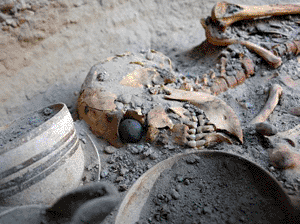

(Courtesy The Circle of Ancient Iranian Studies)
If there were any doubts that eastern Iran was a sophisticated and populous region in the third millennium B.C., the vast cemetery at Shahr-i-Sokhta has put them to rest. Over the past two decades, a team led by Iranian archaeologist Mansour Sajjadi has been working in a 100-acre area that includes an estimated 40,000 graves—and possibly as many as 200,000—dug over a period of many centuries, only 100 of which have thus far been excavated. According to archaeologist Kirsi Lorentz at the University of Newcastle, who is working on the finds from the site, the cemetery offers "a unique record with which to study the development of urban civilization in the third millennium B.C."
One of the most intriguing finds is the well-preserved remains of a woman in her late 20s who died between 2900 and 2800 B.C. She was buried with an ornate bronze mirror and what Sajjadi and Italian excavators believe is an artificial eyeball made of bitumen paste and gold that was once held in place with fine thread. Microscopic examination showed that the artificial eyeball left an imprint in her eye socket, a sign that it was there for a long period of time before her death. Other archaeologists insist that the object is more likely an eyepatch held in place by string threaded through holes on each side.
Another important find was an intricate rectangular wooden board with 60 small, round pieces made from wood inlaid with bone and limestone, likely an early form of backgammon. Similar sets have been found in the Indus far to the east, as well as in the tomb of Queen Puabi in the Royal Graves of Ur. The board in Shahr-i-Sokhta is approximately the same date as the Indus and Mesopotamian artifacts, and suggests that the people of eastern Iran traded not only goods, but ideas for entertainment as well.
Lorentz says that the cemetery's large numbers will allow for statistical analysis of health, diet, and mobility among the ancient residents. And though the bones are often in poor condition, she adds that there is "exceptional preservation" of human hair, nails, and skin. Grooves found in the teeth of many individuals may be a sign that weavers used their teeth as third hands. Short hair found on the skulls may show that crew cuts were the fashion—at least in death if not in life.
Andrew Lawler is a contributing editor at ARCHAEOLOGY. For our 1975 coverage of the excavations at Shahr-i-Sokhta, see archive.archaeology.org/iran.
Advertisement

Advertisement









